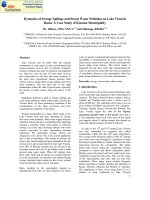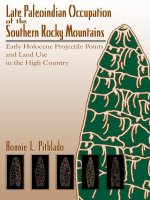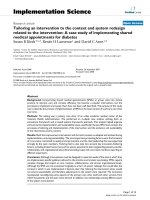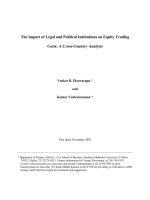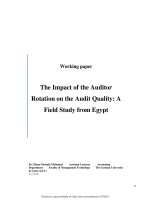Impact of agriculture and land use on ground water quality: A case study of Ladakh cold arid region
Bạn đang xem bản rút gọn của tài liệu. Xem và tải ngay bản đầy đủ của tài liệu tại đây (390.5 KB, 9 trang )
Int.J.Curr.Microbiol.App.Sci (2019) 8(9): 1447-1455
International Journal of Current Microbiology and Applied Sciences
ISSN: 2319-7706 Volume 8 Number 09 (2019)
Journal homepage:
Original Research Article
/>
Impact of Agriculture and Land Use on Ground Water Quality:
A Case Study of Ladakh Cold Arid Region
Jigmet Yangchan1, Sonam Dawa2*, M. S. Raguwanshi3,
Phuntsog Tundup4 and Vikas Gupta4
1
HMAARI, SKUAST-K, Leh-Ladakh-194101 (J&K), India
National Research Institute for Sowa-Rigpa (NRIS)-Leh, CCRAS, Ministry of AYUSH, India
3
ICAR-National Bureau of Soil Survey and Land Use Planning, Nagpur-440033 (MS), India
4
Krishi Vigyan Kendra (KVK)-Stakna, SKUAST-K, Leh-Ladakh, India
2
*Corresponding author
ABSTRACT
Keywords
Fertilization, undecomposed
manure, ground
water, water
reservoir.
Article Info
Accepted:
15 August 2019
Available Online:
10 September 2019
Water reservoirs are always characterized for drinking water quality.
However, in catchments where arable fields dominate, the impact of
agriculture on water pollution is still problematic. In Ladakh, recently the
fertilization level has decreased drastically due to detrimental impact on
soil conditions, mostly for economic reasons as well as lastly getting more
awareness on benefits of organic farming towards maintaining indigenous
traditional knowledge/ methodologies. However, almost few villages still
apply fertilizers as starter dose to boost the crop emergence as well as
adding un-decomposed manure cum night soil in their field due to declining
trend in livestock size per household. In order to evaluate the impact of
agriculture on water quality in a water reservoir with a high proportion of
arable fields adjoining to reservoir were monitored. Present study was
carried out in Gangles Gompa village situated 5 km upper side of Leh
market with stone meant to provide drinking water for 40% population of
Leh city. The aim of the study were to assess (1) the impact of agriculture
land on groundwater, and running water quality and (2) impact of drains on
aquatic animals and human health.
Introduction
Water reservoirs for drinking purpose are
expected to be characterized by good water
quality. However, in catchments area where
arable fields dominate, the impact of
agriculture on water pollution becomes
important. Eutrophication is a key factor
causing degradation of water quality, which
1447
Int.J.Curr.Microbiol.App.Sci (2019) 8(9): 1447-1455
restricts its use. Recently, agriculture is
recognized as a major source of water
pollution, (Billen et al., 2013; Fowler et al.,
2013). Degradation of soil and water from
agriculture occur due to residues of used
chemicals
(pesticides),
emission
of
ammonium, methane or sulfide from livestock
production, and livestock manures. One of the
most problematic is nitrogen and phosphorus
leaching from arable fields to groundwater and
surface water as a result of higher amounts of
these nutrients applied in natural and mineral
fertilizers compared to plant requirements or
supplied in adverse conditions (Billen et
al., 2013; Kyllmar et al.,2014 b). The major
excessive N inputs from agriculture have been
identified as a major contributor to stream N
loadings (Boyer et al., 2002, Hatano et
al., 2005; Garnier et al., 2010). Nutrient
leaching depends on several factors: primarily
fertilization level, type, and timing of fertilizer
application; the method of their application to
the soil; properties of soils (i.e., pH, structure
and organic matter content), types of crops
and their fertilizer requirements; method of
cultivation and agronomic practices; and the
level of animal production (Bechmann 2014,
Kyllmar et al.,2014a and 2014(b)). Weather
conditions and catchment land use also have a
crucial impact on the intensity and quantity of
nitrogen leaching (Jiang et al.,2014;
Yoon 2005; Woli et al.,2008).
A key factor in determining plant nutrient
uptake is also the availability of micro- and
macro-elements in the soil, particularly mass
ratios between elements (Cakmak 2005;
Fageria 2001;
Güsewell
et
al., 2003;
Szczepaniak et al., 2013). An insufficient
amount of potassium reduces nitrogen uptake
by plants and thereby may increase nitrogen
leaching from soil (Lawniczak et al., (2009)
and Lawniczak (2011). Also, deficient
availability of phosphorus causes decreased
plant biomass, even when nitrogen is in an
optimal concentration compared to plant
requirements
(Güsewell 2004.
However,
relationships between these elements are not
well understood in terms of nutrient leaching
in agricultural areas.
Nitrogen, in particular the very soluble nitrate,
is easily dissolved into the percolating water.
Phosphorus is less mobile and reaches surface
water due to erosion with the bound soil
particles. These different pathways cause a
problem with water protection, because
elimination of one water pollution source may
aggravate another. For example, reduction of
fertilization level or one of the elements may
not reduce leaching of nutrients as a result of
the unfavorable ratio of nutrients in soil.
Deficiency of phosphorus or potassium limits
the uptake of nitrogen by plants, even when
the nitrogen level is sufficient (Lawniczak et
al., 2009). This suggests that at a low level of
fertilization due to shortage of potassium and
phosphorus, there may occur loss of nitrogen,
which results in water and soil pollution. This
issue may concern two thirds of the world’s
agricultural land where potassium deficiency
occurs (Romheld and Kirkby 2010).
The necessity of measures to reduce the
negative impact of agriculture on water quality
results from the provisions of European
Commission Council Directive 91/676/EEC
(i.e., the Nitrate Directive) concerning the
protection of waters against pollution caused
by nitrates from agricultural sources. In
Poland, these activities are obligated in the
designated Nitrate Vulnerable Zones (NVZs),
which were introduced as special actions
based on local law. However, nitrogen
pollutants affect more areas (Iital et al., 2014;
Rozemeijer et al., 2014; Wendland et
al., 2009), even where the nitrate level is
exceeded occasionally. Particularly, they
should be focused on protected areas that are
characterized by a large proportion of
agricultural land.
1448
Int.J.Curr.Microbiol.App.Sci (2019) 8(9): 1447-1455
The Wielkopolska region is one of the most
developed agricultural areas in Poland. A high
proportion of agricultural land cover types in
the region carry the risk of water pollution.
The fertilization level in this part of Poland
was always higher than in other parts of
Poland (GUS 1952–2013). However, recently,
these differences significantly decreased and
application of fertilizers is at the level
recommended in terms of water and soil
protection against pollution from agricultural
sources (Codex of Good Agricultural
Practice 2004).
In order to recognize the impact of agriculture,
particularly supply of fertilizers, on water
quality in the protected area, complex
monitoring has been applied. The study was
carried out in Wielkopolska National Park and
its buffer zone, which are also protected as
Natura 2000 sites. In this area, open water
bodies are characterized by poor water quality
(Lawniczak unpublished results). Knowledge
of the impact of agriculture on groundwater
quality, particularly the most problematic nonpoint sources, is crucial for a proper protection
strategy for this area.
The aim of the study were (1) to assess the
impact of agriculture, particularly fertilization
and un-decomposed manure, on quality of
groundwater and running water; (2) Induces of
drainage of water on aquatic animals and
human health (3) to provide recommendations
and suggestions for conserving valuable water
reservoir.
Study area
The study was carried out in the GanglesGompa dug-well water reservoirs, located in
the Gompa village, about 5 km from Leh main
bazaar at an elevation in between 34°12’
77°35’ to 34°11’ 77°35’. The dug-well was
established around in 1980 by PHE
department drinking water supply for Leh city.
The concept of this dug well is to collect the
discharge getting from spring and deliver to
public for drinking purpose and to reduce the
human impact as well as animal on the pond
and also improve the efficiency of pond
protection of fencing were also done.
Currently, the pond fencing was damages
from one side, the whole concept behind this
dug well get reversed in which dogs and cow
dropping, instead of spring water, drainage of
agriculture as well as 50% chances of septic
water also enters in this dug well by the
observation of farmers in this area as well our
observation in field. This water level of dug
well remains low in winter season. Once the
irrigation started in summer the pond water
level started rising.
As the chances of leaching and seepage from
the agriculture as well as from septic tanks of
habitats in this dug well is around 90% due to
high elevation of field and habitats then dug
well. Still 40% of water is delivered by PHE
to Leh city in which following areas were
covered, Part of Gonpa, Sankar, Lamdon,
Chupi, Zangsti etc are still cover through this
dug well for drinking purpose.
Materials and Methods
The study was carried out during year 2018-19
as per questions raised by Gompa village
farmers that lots of small worms and
sometime received dead fish from their
drinking water have been observed from tap
water supply. On report, main water reservoir
was observed accordingly and water testing
carried out with the help of TDS, pH meter,
using VSI water testing kit in which physical
property of water quality were tested per the
ecological status of dug well.
Judge the following data provided by
Department of Agriculture on utilization of
chemical fertilizer use in Leh District (unit
quintals) may be the one cause of water
pollution.
1449
Int.J.Curr.Microbiol.App.Sci (2019) 8(9): 1447-1455
Year
1990
Urea
3537
DAP
1795
MOP
37
Total
5369
1991
4172
2157
52
6384
1992
4369
2237
90
6696
1993
3544
592
33
4171
1994
3741
1034
13
4788
1995
5814
1809
19
7642
1996
3567
1345
1
5913
1997
4310
1563
106
5979
1998
7055
2830
55
9940
1999
5542
2352
8
7902
2000
3693
1894
Nil
5587
2001
4003
2035
71
6109
2002
3756
2245
32
6033
2003
2296
1842
Nil
4138
2004
3570
2430
68
6068
2005
3537
2566
10
6113
2006
3710
2626
8
6344
2007
3748
2965
1
6714
2008
3660
2719
75
6454
2009
4058
3187
119
7364
2010
3735
3341
165
7241
2011
3547
3177
10
6734
2012
3689
3489
142
7320
2013
3606
3378
107
7091
2014
3498
2922
83
6503
2015
3634
2705
81
6420
2016
3100
3000
49
6149
2017
3100
3099
25
6224
2018
2884
2296
147
5327
In initial stage this dug well is only design for
harvest spring water still today it supply
drinking water in 40% of Leh area includes
(Gompa, Chubi, Khakshal, Lamdon, Police
Thana). But during summer and during
irrigation period the water level reach up to
half of dug well as compared to normal water
level in winter. During observation it was
noticed that most of the area under arable
fields in the catchment. Impact of agriculture
land and habitats which is located at higher
elevation compared to pond is positive and
60% Algae blossom in dug well. Shirley Sharpe
mention in aquarium that nitrate levels as low as
10 ppm will promote algae growth. Algae
blooms in newly setup well due to elevated
nitrate levels. Similarly, Dolma et al., 2015
reported in Baseline Study of Drinking Water
Quality–A Case of Leh Town, Ladakh (J&K),
India it was observed the nitrate content of
water samples in the study area was varied
from 0 mg/l to 1.00 mg/l with mean value of
0.16 mg/l during pre-monsoon and between 0
mg/l to 0.97 mg/l with mean value of 0.16
during post monsoon. Its shows that in the
study area the nitrate concentration might be
within 10 ppm when the growth of algae if we
observed. Algal growth decline DO level
causing mortality of fishes and contaminate
further. As per, farmer observation they found
small worms and dead fishes in their drinking
water its shows the DO level of water is low in
that water. Water is cloudy with moderate
turbidity within the range of 0-50 NTU during
winter and after irrigation.
Eutrophication is a key factor causing
degradation of water quality of dug well. In
these area farmers using un-decomposed
manure and fertilizer for substitute, so
definitely 80% chances of nitrate, nutrients, Ecoli presence in water through leaching as
well as seepage. People of the surrounding
villages were interviewed and water testing
analysis were took placed following
symptoms in water bodies was observed.
1450
Int.J.Curr.Microbiol.App.Sci (2019) 8(9): 1447-1455
Water moving through soil carries many
soluble ions with it in the process of leaching
which is a natural phenomenon occurring
following rainfall or irrigation exceeds the
field capacity of soil. Since nitrate is soluble
in water and mobile in the soil, it readily
moves with any water passing beyond the root
zone. Given sufficient time and water, nitrate
may eventually reach groundwater and
running water through our drinking tape
water.
Results and Discussion
The impact of agriculture on water quality is
definitely acknowledged due to increase rate
of nutrient supply in dug well not directly but
through seepage or leakages during irrigation
period boost the algae population in dug well.
Keeping above observations in mind the
following recommendations and suggestions
are very important to keep the water around to
the safe limit for drinking purpose.
The desirable limits of nitrates in nature are
below 5ppm which generally, a very low
nitrates. In fresh drinking water, nitrates should
be kept below 10ppm to reduce algae growth as
well as reduce prevent health hazard. Similarly,
for aquariums, nitrates should be kept below 50
ppm at all times, preferably below 25 ppm.
It is regulated in drinking water primarily
because
excess
levels
can
cause
methemoglobinemia, or "blue baby" disease.
In this area children are facing problem of low
Hb and pregnant women also facing such
problem.
It was also observed that in Leh area chemical
fertilizer utilization remain varies from 4171
to 9940 quintals from1998 to 2018 and more
chances of water pollution in this area due to
vegetable grower.
Water quality is cloudy, opaque, and muddy
taste. Its changes its color during winter and
after irrigation in summer. Its range varies
from 0-50NTU. As for drinking purpose it
should be less then 5NTU.So proper filter unit
is must this areas.
Before supply water to public, nitrates levels
should be checked every fortnightly so, you
know if the levels are unusually high in your as
per the particular water source. If nitrates are
above 10 ppm, one should consider other water
sources that are free of nitrates.
As the Dug-well should be well protected if
human consumption is concerned and should
be covered with lid and walls to reduce
lighting where there is direct sunlight for even
part of the day. Sunlight can, and will,
sometimes provide desired level of
temperature at high altitude to promote algae
growth. When using artificial light, make sure
it is not stronger than necessary and is not on
more than about eight hours each day.
Drain water reservoir
The single most important way to avoid algae
is to perform regular water changes through
drains at least 10 to 15% water should change.
Regular water testing of dug well before
supply to public; and also, to check nitrates
level sometime water sources have high
elevated nitrates.
Clean of dug well
If algae beginning to grow on the, rocks, or
other hard surfaces of the well the remove it.
Scrape the glass, remove rocks, and scrub
them. Vacuum the gravel when you perform
water changes. Frequently chlorination is
must.
1451
Int.J.Curr.Microbiol.App.Sci (2019) 8(9): 1447-1455
Fig.1
Fig.2
1452
Int.J.Curr.Microbiol.App.Sci (2019) 8(9): 1447-1455
Table.1
S.No. Parameter
1
2
Turbidity
Color
3
4
5
6.
Odor
Temperature
of water
pH
TDS
7.
Nitrate
Max. permissible Desirable
limit for drinking limit
water
< 5NTU
< 1NTU
Observed
Data
<50NTU
Opaque
<25 C
<10 C
Muddy smell
270C
2000 mg/l
6.6 to 8.4.
<500ppm
5.2
>250ppm
<10mg/l
1mg/1
<10ppm
0
0
Maintaining algae-eating fish
Keeping Siamese flying fox, otocinclus, or
even the common plecostomus, will help
reduce some of the algae in the dug well.
Installation of high quality water filtration
unit;
Community and policy makers’ initiatives to
conserve ponds of Ladakh
Water consumption policy is required to be
framed to including all stakeholders to
maintain pond for drinking purpose;
Timely Maintenance of dug-well.
Punishment or penalty should be imposed to
avoid
adulteration
with
human
consumptive water body.
References
Bechmann M. 2014. Nitrogen losses from
agriculture
in
the
Baltic
Sea
Remark
Moderate turbidity
Due to seepage
from
agriculture
land
Exposure of direct
sunlight
Acid in nature
Slightly high for
drinking
Chances
of
leaching in dug
well after seeing
Algae growth
region. Agriculture, Ecosystems and
Environment. 198(15): 13–24.
Billen G., Garnier J. and Lassaletta, L. 2013.
The nitrogen cascade from agricultural
soils to the sea: modeling nitrogen
transfers at regional watershed and
global
scales. Philosophical
Transactions of the Royal Society 368:
1–13.
Boyer, E.W., Goodale, C.L., Jaworski, N.A.
and Howarth, R.W. 2002. Antropogenic
nitrogen sources and relationships to
riverine nitrogen export in the
northeastern
USA. Biogeochemistry
57(58): 137–169.
Cakmak, I. 2005. The role of potassium in
alleviating determinable effects of
abiotic stresses in plants. Journal of
Plant Nutrition and Soil Science 168:
521–530.
Codex of Good Agricultural Practice. Ministry
of
Agriculture
and
Rural
Development. Varsow: Ministry of the
Environment; 2004.
Fageria, V.D. 2001. Nutrient interactions in
1453
Int.J.Curr.Microbiol.App.Sci (2019) 8(9): 1447-1455
crop plants. Journal of Plant Nutrition
2498: 1269–1290.
Fowler, D., Coyle, M., Skiba, U., Sutton,
M.A., Cape, J.N. and Reis, S. 2013. The
global nitrogen cycle in the twenty-first
century. Philosophical Transactions of
the Royal Society 368: 201-210.
Garnier, M., Recanatesi, F., Ripa, M.N. and
Leone, A. 2010. Agricultural nitrate
monitoring in a lake basin in central
Italy: a further step ahead towards an
integrated nutrient management aimed at
controlling
water
pollution.
Environmental
Monitoring
and
Assessment 170: 273–286.
GUS (1952, 1961, 1971, 1981, 1991, 2010,
2011, 2013). Central Statistical Office of
Poland; />Gusewell, S. 2004. N: P ratios in terrestrial
plants:
variation
and
functional
significance. New Phytologist. 164: 243–
266.
Gusewell, S., Koerselman, W. and Verhoeven,
J.T.A. 2003. N: P ratios as indicators of
nutrient limitation for plant populations
in
wetlands. Ecological
Applications 13(2): 372–384.
Hatano, R., Nagumo, T. and Kuramochi, K.
2005. Impact of nitrogen cycling on
stream water quality in a basin
associated with forest, grassland, and
animal
husbandry,
Hokkaido,
Japan. Ecological Engineering 24: 509–
515.
Iital, A., Kloga, M., Pihlak, M., Pachel, K.,
Zahharov, A. and Loigu, E. 2014.
Nitrogen content and trends in
agricultural
catchments
in
Estonia. Agriculture Ecosystems and
Environment 198: 44–53.
Jiang, R., Hatano, R., Zhao, Y., Woli, K.P.,
Kuramochi, K., Shimizu, M. and
Hayakawa, A. 2014. Factors controlling
nitrogen and dissolved organic carbon
exports across timescales in two
watersheds
with
different
land
uses. Hydrological Processes 28: 5105–
5121.
Kyllmar, K., Bechmann, M., Deelstra, J., Iital,
A., Blicher-Mathiesen, G. and Jansons,
V. 2014. Long-term monitoring of
nutrient losses from agricultural
catchments in the Nordic-Baltic region:
a discussion of methods, uncertainties
and
future
needs. Agriculture,
Ecosystems & Environment 198: 4–12.
Dolma, K., Rishi, M.S. and Herojeet, R. 2015.
Baseline Study of Drinking Water
Quality– A Case of Leh Town, Ladakh
(J&K), India. Hydrology Current
Research 6(1): 100-108.
Dolma, K., Rishi, M.S. and Lata, R. 2015. An
Appraisal of Centralized Waste Water
Treatment Plant with Respect to Leh
Town. International Journal of Science
and Research 4(5): 121-129.
Kyllmar, K., Stjernman, Forsberg L,
Andersson S. and Martensson, K. 2014.
Small
agricultural
monitoring
catchments in Sweden representing
environmental
impact. Agriculture,
Ecosystems & Environment 198: 25–35.
Lawniczak, A.E., Choinski, A. and Kurzyca, I.
2011. Dynamics of Lake Morphometry
and bathymetry in various hydrological
conditions. Polish
Journal
of
Environmental Studies 20(4): 931–940.
Lawniczak, A.E., Gusewell, S. and
Verhoeven, J.T.A. 2009. Effect of N: K
supply ratios on the performance of three
grass
species
from
herbaceous
wetlands. Basic and Applied Ecology
10(8): 715–725.
Romheld, V. and Kirkby, E.A. 2010. Research
on potassium in agriculture: needs and
prospects. Plant and Soil 335(1-2): 155–
180.
Rozemeijer, J., Klein, J., Broers, H., TolLeenders, T. and Grift, B. 2014. Water
quality status and trends in agriculturedominated headwaters; a national
monitoring network for assessing the
1454
Int.J.Curr.Microbiol.App.Sci (2019) 8(9): 1447-1455
effectiveness of national and European
manure
legislation
in
The
Netherlands. Environmental Monitoring
and Assessment 186(12): 8981–8995.
Szczepaniak, W., Barłog, P., Lukowiak, R.
and Przygocka-Cyna, K. 2013. Effect of
balanced nitrogen fertilization in fouryear
rotation
on
plant
productivity. Journal
of
Central
European Agriculture 14(1): 64–77.
Wendland, F., Behrendt, H., Gomann, H.U.,
Hirt, P., Kreins, U. and Kuhn, R. 2009.
Determination of nitrogen reduction
levels necessary to reach groundwater
quality targets in large river basins: the
Weser
basin
case
study,
Germany. Nutrient
Cycling
in
Agroecosystems 85: 63–78.
How to cite this article:
Jigmet Yangchan, Sonam Dawa, M. S. Raguwanshi, Phuntsog Tundup and Vikas Gupta 2019.
Impact of Agriculture and Land Use on Ground Water Quality: A Case Study of Ladakh Cold
Arid Region. Int.J.Curr.Microbiol.App.Sci. 8(09): 1447-1455.
doi: />
1455


